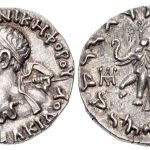Basics
- The earliest account of issuing coins dates back to the 7th-6th Century BCE.
- These coins were ‘punched-mark’ coins made in silver.
- They were initially issued by merchant guilds.
- The earliest coins were casted coins and were die-struck only on one side.
- Panini’s Ashtadhyayi cites that to make punch marked coins, metallic pieces were stamped with symbols.
- Each unit was called ‘Ratti’.
Classification
- Punch-marked coins issued by various Mahajanapadas
- The first Indian punch marked coins called Puranas, Karshapanas or Pana were minted in the 6th century BCE.
- These coins had irregular shapes, standard weight and were made up of silver with different markings like Saurashtra had a humped bull, Dakshin Panchala had a Swastika and Magadha had generally five symbols.
- They were mentioned in the Manusmriti and Buddhist Jataka stories.
- Punch marked coins during Mauryan Period
- Chanakya, the Prime Minister to the first Mauryan emperor Chandragupta Maurya, mentioned the minting of punch marked coins such as rupyarupa (silver), suvarnarupa (gold), tamrarupa (copper) and sisarupa (lead) in his Arthashastra treatise.
- Out of the various symbols used, sun and six armed wheel were most consistent.

